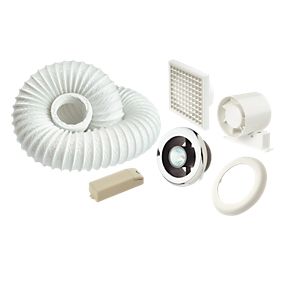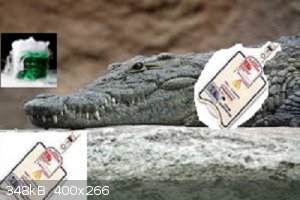Cognition
Harmless

Posts: 4
Registered: 23-11-2015
Member Is Offline
Mood: No Mood
|
|
DIY Fume hood
Hi, I'm taking my first steps in hobby chemistry; although I've worked professionally (sometimes unprofessionally) in a lab for many years.
A likely area of interest will be polyurethanes which will mean handling isocyanates so I will need to construct a fume hood on a limited budget. I'm
thinking of buying a cheap second-hand kitchen cupboard (or similar), replacing the doors with a transparent polycarbonate sash and fitting a small
shower extractor fan (see pic).
The construction is unlikely to be wholly air-tight. Does anybody know if a small shower extractor fan is likely to do the job in this arrangement?
I intend to wear an isocyanate monitoring badge so I should be aware of any leaks once I start working but I'd like to have some idea of success
before I spend the time and effort.
I'm guessing some of you have built fume hoods in the past so any advice is appreciated (e.g. fire extinguisher and other requirements).

|
|
|
aga
Forum Drunkard
    
Posts: 7030
Registered: 25-3-2014
Member Is Offline
|
|
Hi.
Fume hoods are a very good idea.
Please search in the forum before starting a brand new thread when there exist many threads talking about the same thing.
http://www.sciencemadness.org/talk/viewthread.php?tid=31918
http://www.sciencemadness.org/talk/viewthread.php?tid=21508
http://www.sciencemadness.org/talk/viewthread.php?tid=11841
http://www.sciencemadness.org/talk/viewthread.php?tid=24216
http://www.sciencemadness.org/talk/viewthread.php?tid=14233
http://www.sciencemadness.org/talk/viewthread.php?tid=13052
http://www.sciencemadness.org/talk/viewthread.php?tid=11755
http://www.sciencemadness.org/talk/viewthread.php?tid=23508
http://www.sciencemadness.org/talk/viewthread.php?tid=208
http://www.sciencemadness.org/talk/viewthread.php?tid=11145
I did the same when i got started
http://www.sciencemadness.org/talk/viewthread.php?tid=29710
|
|
|
Cognition
Harmless

Posts: 4
Registered: 23-11-2015
Member Is Offline
Mood: No Mood
|
|
Thanks for the links aga. I did a search for 'fume hood' before posting but found so many irrelevant results.
I like your construction and it's similar to what I was thinking for myself. I think I will use something more powerful than a pc fan however as I'll
be working with isocyanates so I need to be extra careful.
The LED lighting is worth considering at a little extra cost. Did you use glass panel for the sash? I think I will use a polycarbonate greenhouse
panel - shatter proof and much lighter.
|
|
|
aga
Forum Drunkard
    
Posts: 7030
Registered: 25-3-2014
Member Is Offline
|
|
Polycarbonate sounds like a better plan, so long as you're not going to use nasty stuff that dissolves/reacts with polycarbonates.
The search feature on this site basically doesn't work.
All those links i found on google, using this magic formula :
site: sciencemadness.org [whatever-i-wanted-to-know]
That brings up just about EVERYTHING you would wish to know about a chemical-related question.
What will you do if the isocyanate badge says 'Dead' ?
Also, what if the lab catches on fire ? Bucket of water on hand and a fire extinguisher.
Get some Plans in place if you're going to start messing with dead-ing compounds.
E.g. at least inform someone you're about to attempt a deadly systhesis, and inform them of the precautions to take whilst approaching the corpse.
I have no knowledge of isocyanates, so am probably over-reacting.
|
|
|
chemrox
International Hazard
    
Posts: 2961
Registered: 18-1-2007
Location: UTM
Member Is Offline
Mood: LaGrangian
|
|
I'm not sure about the bathroom fan although I've seen diy hoods that used computer fans. You could test it: buy some cigarettes and smoke them while
you're running anything that could release HCN. If you smell almond extract bail and get a better fan. I bought a hood for the price of shipping but
since my lab is on rented facilities it had to be installed by HVAC folks. Also I wanted better ventilation so the hood installation tied in with the
exhaust fan installation. The roof is flat and doesn't support much weight so the fan had to go on the exterior wall. It's a killer fan which lets me
handle toxic solvents anywhere in the lab. The whole project cost me $2400. In spite of the high air exchange rate I keep a mask nearby. I have
filters for fine particles like silica and organic vapor filters that also capture chlorine and HCN. I recommend having a mask as well as safety
glasses.
"When you let the dumbasses vote you end up with populism followed by autocracy and getting back is a bitch." Plato (sort of)
|
|
|
Dr.Bob
International Hazard
    
Posts: 2658
Registered: 26-1-2011
Location: USA - NC
Member Is Offline
Mood: No Mood
|
|
The isocyanates used in most polyurathane chemistry are far less nasty than smaller MW ones, like methyl and ethyl. Most are
bis(isocyanonato)benzenes or xylenes. We used them in an open undergraduate lab and they sell them as Gorilla Glue. Not that you want to breathe
them, but they are not very volatile. I presume that you are mixing them with various amounts of diols and triols and other modifiers? Most of
those are also not too volatile.
So a good bath or kitchen fan should work OK if that is what you are doing. If you are making the isocyanates yourself (normally done with phosgene
or its equivalents), then you need to do a much better job with professional hoods and special equipment. I have done that some, and don't miss it at
all.
|
|
|
Cognition
Harmless

Posts: 4
Registered: 23-11-2015
Member Is Offline
Mood: No Mood
|
|
I agree Dr Bob; most isocyanates (HCN) used commercially are trimers or prepolymers thus have low vapour pressure and are harmless at ambient
temperatures. PPE is recommended only when the HCN is atomised from a spray gun.
In my case I intend reacting HCN with diols and polyols. As these reactions proceed at ambient temperature there should not be a significant hazard.
However I may also wish to synth allophanates; formed from one mole of a mono-functional alcohol with two moles isocyanate. In order to progress this
reaction to completion it requires temperature >100 C. And this is where my concern lies.
I wish I could afford chemrox's lab but I can't. Instead I shall proceed with caution. An isocyanate monitoring badge will turn red way before levels
of HCN become dangerous so this is my early warning to shut the reaction down and get the hell out of the room.
It's very good advice from aga to have a plan of action for the worst case scenario. In actual fact breathing in isocyanate is unlikely to kill you
but it can sensitise your lungs. I happen to know a colleague who became sensitised to HCN - it turned his life upside down. He can barely walk
outside his house if there is pollen in the air. If someone uses aerosol deodorant he starts chocking for breath. Unfortunately I think he will be
like that for the rest of his life - he's in his early forties.
You may ask; why don't I take on a less dangerous project. I think when you have that spark of inspiration, that one truly inventive idea then you owe
it to yourself to pursue the possibility. It may not work but I'd hate to say that I never tried.
|
|
|
aga
Forum Drunkard
    
Posts: 7030
Registered: 25-3-2014
Member Is Offline
|
|
It is Excellent that you are thinking this through and asking for advice.
I have the expectation that you will perform the synthsis and survive, then post the results in this thread with some photos of before/after.
Get 2 badges.
One near your breathing holes and the other off-body, between you and the reaction, somewhere you can see/check it easily and frequently.
If that one goes red, shut down heating then run away, then check the one you're wearing.
I usually use this arrangement

[Edited on 24-11-2015 by aga]
|
|
|